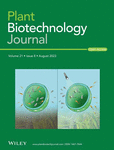Journal list menu
Export Citations
Download PDFs
Issue Information
Issue Information
- Pages: 1511-1512
- First Published: 22 July 2023

Front cover image:
By combining GWAS and transcriptome analyses with gene-editing techniques, we have identified two S genes, RNG1 and RNG3. In different rice varieties, there is a correlation between the polymorphisms in the 3’-UTR of these genes and their expression levels, are negatively associated with disease resistance. Editing the 3’-UTR or knocking out either of the two genes in rice can improve resistance against both rice blast and bacterial blight. The left side of the figure shows the normal condition, whereas the right side shows the increased resistance after editing RNG1 or RNG3. Cover illustration refers to the article published in this issue (Xu et al., pp. 1628–1641).
Brief Communications
A novel QTL GL12 from wild rice increases grain length and weight in cultivated rice
- Pages: 1513-1515
- First Published: 20 January 2023
Loss of OsHRC function confers blast resistance without yield penalty in rice
- Pages: 1516-1518
- First Published: 27 April 2023
Developing a UV–visible reporter-assisted CRISPR/Cas9 gene editing system to alter flowering time in Chrysanthemum indicum
- Pages: 1519-1521
- First Published: 01 May 2023
The ricebean genome provides insight into Vigna genome evolution and facilitates genetic enhancement
- Pages: 1522-1524
- First Published: 15 June 2023
Genome editing of the susceptibility gene ZmNANMT confers multiple disease resistance without agronomic penalty in maize
- Pages: 1525-1527
- First Published: 30 May 2023
Review Article
Physiological implications of SWEETs in plants and their potential applications in improving source–sink relationships for enhanced yield
- Pages: 1528-1541
- First Published: 18 December 2022
Research Articles
The miR156b–GmSPL2b module mediates male fertility regulation of cytoplasmic male sterility-based restorer line under high-temperature stress in soybean
- Pages: 1542-1559
- First Published: 14 April 2023
The ubiquitin-binding protein MdRAD23D1 mediates drought response by regulating degradation of the proline-rich protein MdPRP6 in apple (Malus domestica)
- Pages: 1560-1576
- First Published: 04 May 2023
Evolution-guided multiomics provide insights into the strengthening of bioactive flavone biosynthesis in medicinal pummelo
- Pages: 1577-1589
- First Published: 28 April 2023
Rice ubiquitin-conjugating enzyme OsUbc13 negatively regulates immunity against pathogens by enhancing the activity of OsSnRK1a
- Pages: 1590-1610
- First Published: 27 April 2023
Inhibition of OsUbc13 activates autoimmune responses, and enhances the activity of OsSnRK1a, one OsUbc13's direct interaction partners, through attenuating its K63-linked polyubiquitination, thereby increasing pathogen resistance in rice.
Comparative transcriptome profiling reveals the multiple levels of crosstalk in phytohormone networks in Brassica napus
- Pages: 1611-1627
- First Published: 08 May 2023
Identification of two novel rice S genes through combination of association and transcription analyses with gene-editing technology
- Pages: 1628-1641
- First Published: 08 May 2023
Genomic analyses provide insights into the polyploidization-driven herbicide adaptation in Leptochloa weeds
- Pages: 1642-1658
- First Published: 08 May 2023
Low temperature compensates for defective tapetum initiation to restore the fertility of the novel TGMS line ostms15
- Pages: 1659-1670
- First Published: 19 May 2023
Metabolic engineering and mechanical investigation of enhanced plant autoluminescence
- Pages: 1671-1681
- First Published: 08 May 2023
The AP2/ERF transcription factor TOE4b regulates photoperiodic flowering and grain yield per plant in soybean
- Pages: 1682-1694
- First Published: 12 May 2023
A dramatic decline in fruit citrate induced by mutagenesis of a NAC transcription factor, AcNAC1
- Pages: 1695-1706
- First Published: 10 May 2023
The RUBY reporter enables efficient haploid identification in maize and tomato
- Pages: 1707-1715
- First Published: 17 May 2023







